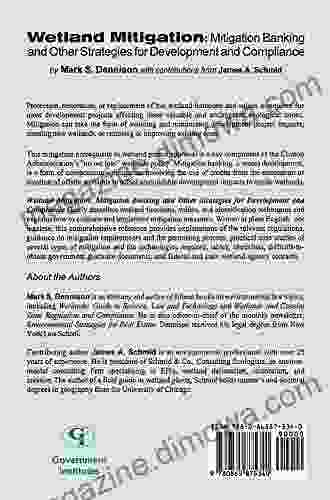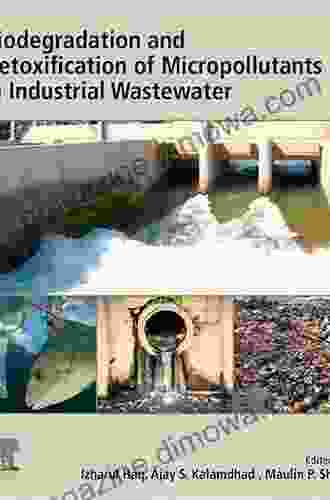Biodegradation and Detoxification of Micropollutants in Industrial Wastewater: Unveiling the Hidden Threat and Empowering Sustainable Solutions

In the ever-evolving landscape of environmental consciousness, micropollutants have emerged as a formidable adversary, posing a significant threat to the delicate balance of our ecosystems. These contaminants, often found in industrial wastewater, are remarkably persistent and resistant to conventional treatment methods, making their removal a formidable challenge.
4.4 out of 5
| Language | : | English |
| File size | : | 16321 KB |
| Text-to-Speech | : | Enabled |
| Screen Reader | : | Supported |
| Enhanced typesetting | : | Enabled |
| Print length | : | 238 pages |
The Insidious Presence of Micropollutants
Micropollutants encompass a wide array of chemical compounds, including pharmaceuticals, personal care products, industrial solvents, flame retardants, and pesticides. Although present in minute concentrations, their cumulative impact can wreak havoc on aquatic life and human health.
These contaminants enter the wastewater stream through various industrial processes, such as manufacturing, textile dyeing, and pharmaceutical production. Once in the environment, they can persist for extended periods, accumulating in water bodies and sediment, where they can have detrimental effects on organisms at all trophic levels.
Biodegradation: Nature's Answer to Micropollutant Woes
Biodegradation offers a promising solution to the micropollutant conundrum. This process harnesses the power of microorganisms, such as bacteria, fungi, and algae, to break down and detoxify these contaminants into harmless substances.
Biodegradation can occur naturally in the environment, but it can be significantly enhanced through engineered systems, known as bioreactors. Bioreactors provide an optimized environment for microbial growth and activity, facilitating the efficient degradation of micropollutants.
Diverse Microbial Arsenal for Micropollutant Mitigation
The biodegradation of micropollutants involves a complex interplay of various microbial enzymes and metabolic pathways. Different microorganisms possess unique capabilities for degrading specific contaminants, making it crucial to select the appropriate microbial consortia for effective treatment.
Bacteria, such as Pseudomonas and Bacillus, are known for their ability to degrade a wide range of organic compounds, including pesticides and pharmaceuticals. Fungi, like white-rot fungi, are highly effective in breaking down recalcitrant pollutants, such as polycyclic aromatic hydrocarbons (PAHs).
Advanced Oxidation Processes: Reinforcing Biodegradation
In some cases, biodegradation alone may not be sufficient to achieve the desired level of detoxification. Advanced oxidation processes (AOPs),such as ozonation and photocatalytic oxidation, can be employed to further break down and mineralize micropollutants.
AOPs generate highly reactive hydroxyl radicals that can oxidize and decompose even the most persistent contaminants. By combining AOPs with biodegradation, a synergistic effect can be achieved, enhancing the overall efficiency of the treatment process.
Case Studies: Success Stories in Micropollutant Removal
Numerous successful case studies have demonstrated the efficacy of biodegradation and detoxification techniques in addressing micropollutant contamination in industrial wastewater.
For instance, a study conducted by researchers at the University of California, Berkeley, showed that a combined biodegradation and AOP system was able to remove over 99% of pharmaceuticals and personal care products from municipal wastewater.
In another study, scientists at the National University of Singapore developed a novel bioreactor that used a consortium of bacteria and fungi to degrade a variety of micropollutants, including pesticides and dyes.
Empowering Sustainable Wastewater Management
The adoption of biodegradation and detoxification technologies is a crucial step towards achieving sustainable wastewater management practices. By effectively removing micropollutants, we can protect aquatic ecosystems, safeguard human health, and preserve the integrity of our environment.
Governments, industries, and research institutions must work together to promote the implementation of these innovative technologies. Through collaborative efforts, we can create a cleaner, healthier future for generations to come.
: Embracing Biodegradation for a Brighter Tomorrow
The biodegradation and detoxification of micropollutants in industrial wastewater is a multifaceted challenge, but it is one that we can overcome through the power of science and innovation. By embracing biodegradation techniques, we can harness nature's inherent ability to heal and restore our environment.
Let us embrace the potential of biodegradation and work together to unlock the enigma of micropollutants, paving the way for a sustainable and thriving future where our water resources are pristine and our ecosystems flourish.
4.4 out of 5
| Language | : | English |
| File size | : | 16321 KB |
| Text-to-Speech | : | Enabled |
| Screen Reader | : | Supported |
| Enhanced typesetting | : | Enabled |
| Print length | : | 238 pages |
Do you want to contribute by writing guest posts on this blog?
Please contact us and send us a resume of previous articles that you have written.
 Book
Book Novel
Novel Page
Page Chapter
Chapter Text
Text Story
Story Genre
Genre Reader
Reader Library
Library Paperback
Paperback E-book
E-book Magazine
Magazine Newspaper
Newspaper Paragraph
Paragraph Sentence
Sentence Bookmark
Bookmark Shelf
Shelf Glossary
Glossary Bibliography
Bibliography Foreword
Foreword Preface
Preface Synopsis
Synopsis Annotation
Annotation Footnote
Footnote Manuscript
Manuscript Scroll
Scroll Codex
Codex Tome
Tome Bestseller
Bestseller Classics
Classics Library card
Library card Narrative
Narrative Biography
Biography Autobiography
Autobiography Memoir
Memoir Reference
Reference Encyclopedia
Encyclopedia Weezie Kerr Mackey
Weezie Kerr Mackey Jim Tully
Jim Tully Joe Bronski
Joe Bronski John Florio
John Florio Susan Broesche
Susan Broesche Keir Graff
Keir Graff Reinhardt Jung
Reinhardt Jung Michael E Newton
Michael E Newton Johnpaul Sahagian
Johnpaul Sahagian Sean Billings
Sean Billings John Kani
John Kani Moritz Thomsen
Moritz Thomsen Shannon Kennedy
Shannon Kennedy John David Mann
John David Mann Peter Neill
Peter Neill Tyler Munson
Tyler Munson John Carroll
John Carroll Luke Daly Groves
Luke Daly Groves Shannon Humphrey
Shannon Humphrey John Glass
John Glass
Light bulbAdvertise smarter! Our strategic ad space ensures maximum exposure. Reserve your spot today!

 Harold PowellDiscover the Profound Journey of Humility: A Literary Masterpiece by Lily...
Harold PowellDiscover the Profound Journey of Humility: A Literary Masterpiece by Lily... Jesse BellFollow ·19.4k
Jesse BellFollow ·19.4k Julio Ramón RibeyroFollow ·6.9k
Julio Ramón RibeyroFollow ·6.9k Haruki MurakamiFollow ·7.1k
Haruki MurakamiFollow ·7.1k Israel BellFollow ·18.1k
Israel BellFollow ·18.1k Cody BlairFollow ·14.2k
Cody BlairFollow ·14.2k Sean TurnerFollow ·5.7k
Sean TurnerFollow ·5.7k Robert Louis StevensonFollow ·2k
Robert Louis StevensonFollow ·2k Javier BellFollow ·6k
Javier BellFollow ·6k

 Joshua Reed
Joshua ReedTake Your Marketing Business Into The Next Level
Are you ready to...

 Aaron Brooks
Aaron BrooksFrom Fourier to Cauchy-Riemann: Geometry Cornerstones
From Fourier to Cauchy-Riemann: Geometry...

 Orson Scott Card
Orson Scott CardUnveiling the Art of Mitigation Banking: A Comprehensive...
In the intricate dance between...

 Victor Hugo
Victor HugoUnleash Your Creativity: A Journey Through the Enchanting...
Prepare to be captivated as we...

 Duncan Cox
Duncan CoxLoad of Bull: An Englishman's Adventures in Madrid
By Simon Bunce ...
4.4 out of 5
| Language | : | English |
| File size | : | 16321 KB |
| Text-to-Speech | : | Enabled |
| Screen Reader | : | Supported |
| Enhanced typesetting | : | Enabled |
| Print length | : | 238 pages |












